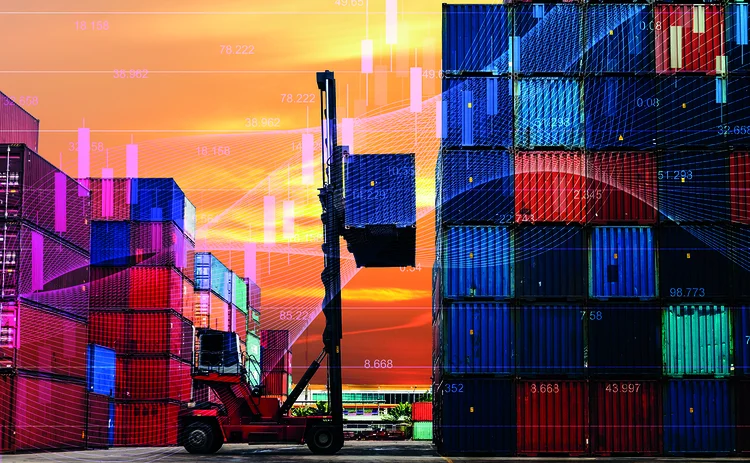

One of the companies taking part in London Metal Exchange’s LME Week in October is Sinara, a firm that has undertaken a lot of work around metals trading systems at different stages of the trade lifecycle.
Sinara has also built systems that handle trading processes for agricultural products—for example, agricultural futures, the management of wheat contracts and trade financing.
Commodities traders are waking up to the fact they can leverage technology advancements to digitalize the commodity trading lifecycle. Technological innovations enable a more connected value chain with more communication and collaboration, smarter decision-making, faster implementations, better access and greater flexibility. But essentially, innovations in technology allow them to improve business processes and increase value. Software specialists such as Sinara are using technology to help transform and modernize a set of business processes that, even now, tend to be quite paper- and phone-driven, or have many manual touchpoints.
The Start of the Trade Lifecycle
Whether placing a buy or sell order, the process can be improved from the very start of the commodities trade lifecycle. Traditionally, you might place an order over the phone with your broker—for so many tonnes of copper, for example. But, according to Hamish Adourian, head of sales and marketing at Sinara: “Brokers and exchanges are under a lot of pressure to modernize business processes. There is a whole new generation of traders coming in who expect new web and mobile apps, and brokers and exchanges are trying to bring in these sorts of digital tools,” he explains. “For the more established companies already dealing with high volumes of financial transactions, the challenge is in managing those while also transforming their technology to keep up with the competition coming from fintech startups.”
For these startups, there is a lot of interest in bringing commodities onto exchanges that traditionally have been traded over the counter. They are looking for more efficient, digital ways of trading these commodities where there has previously not been a lot of transparency, until now.
“No one really knows what the volumes are, and there’s no established price,” says Adourian, “in the way that there is for exchange-traded metals like copper or aluminum, for example. So there are lots of challenges in bringing those sorts of commodities into the new digital marketplace.”
Collateral Management
Using collateral efficiently is an important aspect of starting the process for trading commodity derivatives. Investors and brokers want to minimize margins so they have collateral free to do more trades. “But market pressure to reduce margins must be balanced with the regulatory pressure for higher ones,” Adourian argues. “That’s where different pricing algorithms and models such as value at risk have come in to try and improve collateral allocation, he adds. “And companies are exploring how they can implement that in their trading systems.”
Reducing Settlement Times
Due to manual or paper-based processes, settlement is an area in which there have traditionally been long delays. Intense market volatility in early 2020 because of the Covid‑19 pandemic particularly highlighted the problems caused by delays in settlement times, meaning traders were left unclear about individual trade status or their overall positions.
“Trade execution to completion can often span a period of several days,” says Adourian. “Getting funds and ownership transferred, especially if you’re in different countries, would require actual paperwork to be sent. So there’s a lot of pressure to reduce settlement times. One really important area in which Sinara is seeing a lot of interest is technology to do this in a fast and secure way, where trust is still preserved between the buyer and the seller.”
Proving Ownership and Provenance
For the purposes of trade financing, it has been challenging to prove ownership of more established commodities, where there has been a lot of paper-based activity in the past. “Companies want to make the title of their commodity digital and then securely transfer that to a bank, so they can take out business loans against it more quickly,” explains Adourian. “There’s a lot of work going into transforming that kind of business process and a lot of interest in creating new technologies that can support that.”
And then there is the environmental, social and governance aspect for trade financing. Some banks will only consider giving a loan based on a commodity if they can be assured its provenance is completely safe. Maintaining the virtual paper trail of where a commodity comes from becomes very significant. “If you are buying anything that has been mined, in particular—like gold—they want to be sure the working conditions of the miners are safe and legal, for example, says Adourian. And, with green contracts being introduced, there is also the carbon footprint to watch out for.
“For instance, a commodities trader may need to prove that their aluminum has been smelted using low-carbon processes. So companies are looking at ways of showing that to the marketplace and reassuring traders their commodities are safe.” Companies such as Sinara are helping to provide the technology to deliver all of these new business initiatives.
Delivery and Secure Release
The end of the commodities trading lifecycle is the more physical aspect of delivery. A trader might have bought some wheat, which is stored in silos in France or Belgium, for example, and wants to securely release it and have it delivered to another warehouse or location for consumption. Managing this in a secure way requires thoughtful solutions.
“The process needs to be hacker-proof, so the warehouse can be absolutely sure it is releasing the commodity to the right person and the right delivery company, and that it’s going to the right place. And all that needs to be tracked. There are now digital tools to manage that process in an efficient way, whereas in the past they would have to send signed paperwork back and forth and it took quite a long time to be able to release the commodity,” says Adourian.
No Need to Build From Scratch
Sinara works with businesses to really understand the requirements, and then build a software solution that can support them in whatever area they are seeking to address—be it improving business efficiency or building something new for the market. Whether it’s a new web tool, new mobile app, new pricing tool or a new algorithm, for example, Sinara has a pre-built set of components for the derivatives trading lifecycle, which it can use to speed up the delivery of these new solutions. Adourian adds: “We are not building from scratch, even though these are still bespoke solutions, and businesses get all the benefits of that.”
Sinara will also, where needed, work with the business to integrate any new solution with the IT systems already deployed and in use.
Sinara has one caveat about the available technologies for managing commodities trading. “There is a lot of talk about how blockchain technology can help with solving lots of these issues, such as maintaining digital paper trails, provenance, and so on. That’s all well and good, but businesses should be careful about buying into a technology and then only afterwards starting to think about how to shoehorn the technology into the solution they want to build. They should first think about the business process and what it is they need to achieve, and then consider whether blockchain is what they need. There may be other technologies that might offer better and more cost-effective solutions rather than jumping on the blockchain bandwagon.”
Sponsored content
Copyright Infopro Digital Limited. All rights reserved.
As outlined in our terms and conditions, https://www.infopro-digital.com/terms-and-conditions/subscriptions/ (point 2.4), printing is limited to a single copy.
If you would like to purchase additional rights please email info@waterstechnology.com
Copyright Infopro Digital Limited. All rights reserved.
You may share this content using our article tools. As outlined in our terms and conditions, https://www.infopro-digital.com/terms-and-conditions/subscriptions/ (clause 2.4), an Authorised User may only make one copy of the materials for their own personal use. You must also comply with the restrictions in clause 2.5.
If you would like to purchase additional rights please email info@waterstechnology.com
